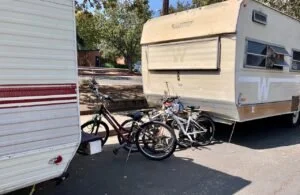Banning RVs is Not About Street Safety
This is a guest blog by SVBC member and Policy Advisory Committee member Janet Lafleur @ladyfleur
Last week my husband came in from a bike ride with the news: “Did you see they put up “no parking” signs in our neighborhood?” I hadn’t, but neither of us were surprised to see signs.
Mountain View’s city officials had been wrestling with whether to prevent “oversized” vehicles parking on city streets for years, finally punting the issue to voters in the November 2020 election. The final result was a ban on parking of any vehicle larger than 22 feet long, seven feet wide or seven feet tall on so-called narrow streets (defined as less than 40 feet in width). The city justified the ban with traffic safety concerns, and in particular, bicycle safety.
Spoiler Alert: It’s not about the bikes
Portable toilet facilities are provided for vehicle dwellers on Wentworth Street where parking large vehicles is now banned.
The city didn’t enforce size restrictions when bicycle safety was the only reason. We bike advocates had complained for years about the huge commercial vehicles parked on Shoreline Boulevard: dump trucks, delivery vans, tree trimming trucks. Even though the trucks and vans were parked well into the bike lane on a busy road, police and city officials told us they couldn’t do anything about it. Nor were officials concerned about cars parked on much narrower, 26 foot wide stretches of the city’s premier bike boulevard.
What the ban is really about is whose vehicles should be allowed to park on city streets.
When the price of rental housing skyrocketed over 50% in the last decade, more Mountain View residents turned to living in vehicles on city streets. Official counts have revealed up to 300 vehicles that serve as housing, primarily parked along non-residential streets. About two-thirds are the larger RVs that exceed the parking ban’s size limits.
The majority of these residents previously rented apartments or homes in Mountain View, but couldn’t afford an extreme rent hike. Some work low-wage jobs, some are retired, some are disabled, some have young children. Most have ties to the community: their jobs are here, their kids attend school here, or their support network of friends and family are here. And many ride bikes.
Bikes and RVs already co-exist without any problems
Bicycles are used as everyday transportation by people who live in the RVs on Mountain View streets.
You’ll find bikes of all sizes are parked next to their vehicles. The most popular RV parking areas are an easy ride or walk to grocery stores, retail and restaurant jobs, local schools, recreational trails, and parks—just like the rental homes, they were priced out of.
Like many of my neighbors living in vehicles, bikes, transit, and walking are my main forms of transportation. Bicycling past RVs is not any more hazardous than bicycling past parked cars. Open car doors stick out further into traffic than RVs do, and RVs rarely have traffic-side doors.
The ban is not about protecting children, either. Relative to a kid’s height, SUVs are just as obstructive as the so-called “oversized” vehicles. And the only children I see anywhere near the RVs are the kids who live in them. Two preschool-aged sweeties regularly wave at me when I ride by on my way to the train. I wave back because that’s what neighbors do.
What cities can do instead of banning RVs
Cities can make some straightforward changes to improve traffic safety around large parked vehicles. Where sightlines are a problem, they can remove parking spaces at the intersection. Where vehicles spill over into bike lanes, they can re-stripe to widen bike lanes by narrowing or removing travel lanes. That’s what Mountain View recently did on Shoreline Blvd and it’s much safer, with or without the large parked vehicles.
More importantly, all of the cities in our region need to address the root cause—a housing crisis that’s driving residents out of homes and into vehicles. Mountain View has instituted rent control protections that have helped keep some residents in their homes. But we simply need to build more housing, both affordable and market-rate, to slow down the displacement of existing residents as employers draw more people into our area for the booming Silicon Valley industry.
To serve the immediate housing needs, we encourage cities to set up safe parking areas with bathrooms and garbage service near shopping, jobs, and schools, so that residents who live in RVs can continue to bike and walk for their daily trips. And not ban them from virtually every street in town.
It’s up to us to push back when city officials or our neighbors try to use bicycle safety as an excuse to push residents out of town. Large parked vehicles aren’t what makes our streets unsafe for bicycling and walking. It’s the moving vehicles of any size, and the city, county, and state policies that prioritize vehicle speed and driver convenience over all of our safety.



